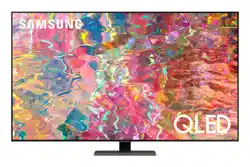Documents: Go to download!
- Owner's manual - (English)

- Connection
- Remote Control and Peripherals
- TV Viewing and Recording
- Picture and Sound
- Troubleshooting
Table of contents
Owner's Guide Smart TV
Connection
Connection Guide
You can view detailed information about external devices that can be connected to the TV.
 >
>  Menu >
Menu >  Connected Devices > Connection Guide
Connected Devices > Connection Guide
It shows you how to connect various external devices, such as video devices, game consoles, and PCs using pictures.
If you select the connection method and an external device, the connection details appear.
- Audio Device: HDMI (eARC), Optical, Bluetooth, Wi-Fi, Wi-Fi Speaker Surround Setup
- Video Device: HDMI
- Smartphone: Screen Sharing (Smart View), Screen Sharing (Tap View), Samsung DeX, SmartThings, Camera Sharing, Apple AirPlay
- PC: HDMI, Screen Sharing (Wireless), Easy Connection to Screen, Apple AirPlay, NFC on TV
- Input Device: Remote Control, USB Keyboard, USB Mouse, USB Gamepad, USB Camera, Bluetooth Device
- Game Console: HDMI
- External Storage: USB Flash Drive, Hard Disk Drive (HDD)
The connection method and available external devices may differ depending on the model.
Some functions may not be supported depending on the model or geographical area.
Using HDMI Troubleshooting, you can check the connection to HDMI cable and external devices (takes approximately 2 minutes).
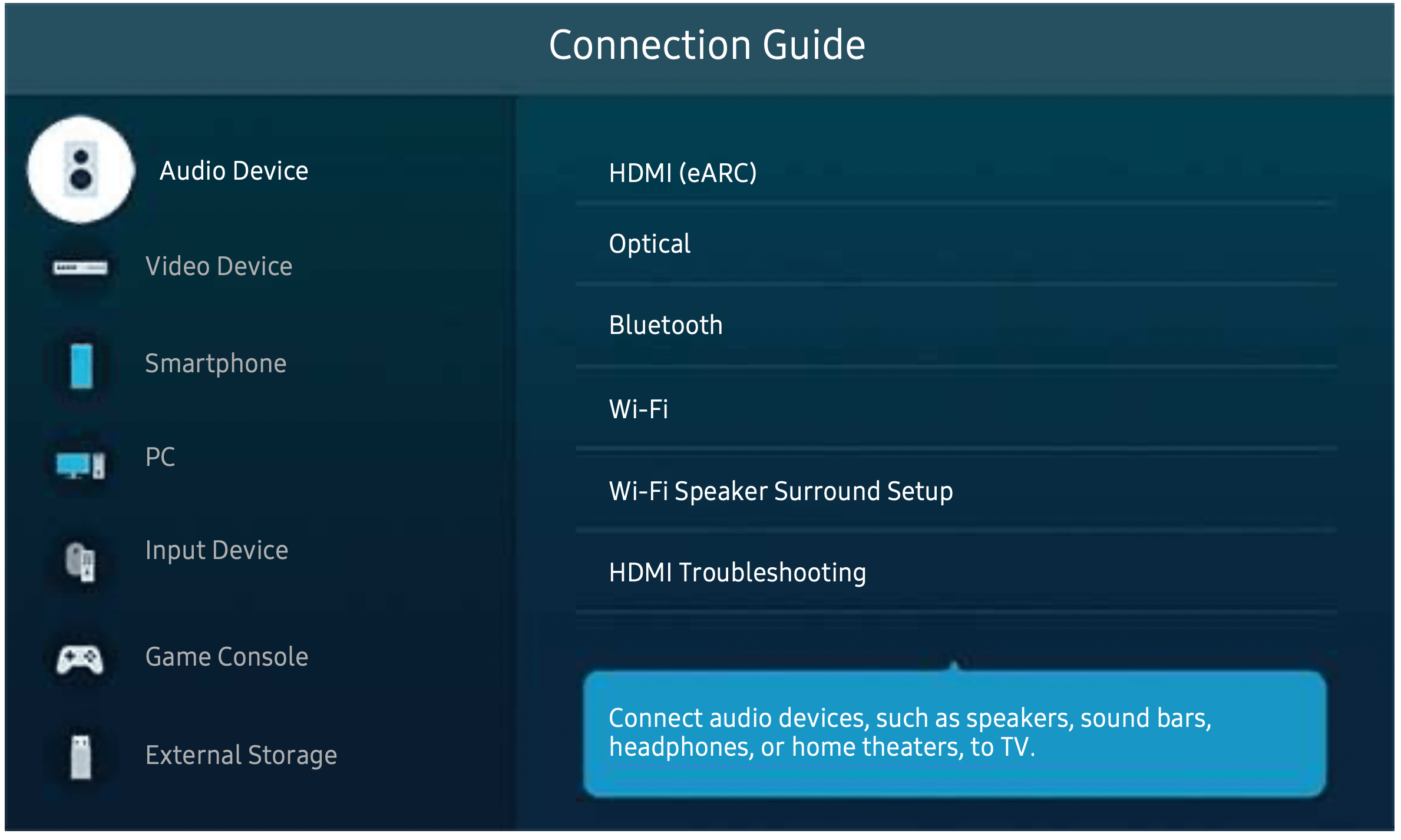
The image on your TV may differ from the image above depending on the model and geographical area.
Connecting an Antenna
You can connect a coaxial cable to your TV.
An antenna connection is not necessary if you connect a cable box or satellite box.
The port on your TV may differ from the following figure depending on the product model and region.

Connecting to the network
You can get access to the network through your TV.
 >
>  Menu >
Menu >  Settings > All Settings > Connection > Network > Open Network Settings.
Settings > All Settings > Connection > Network > Open Network Settings.
Configure network settings to connect to an available network.
Establishing a wired network connection
 >
>  Menu >
Menu >  Settings > All Settings > Connection > Network > Open Network Settings > Wired.
Settings > All Settings > Connection > Network > Open Network Settings > Wired.
If you connect a LAN cable, the TV automatically accesses the network.

- If the TV does not automatically connect to the network, refer to "Wired network connection failed." in "Troubleshooting."
- To connect a LAN cable, use a CAT 7 (*STP type) cable for the connection. (100/10 Mbps)
- Shielded Twisted Pair
- The TV will not be able to connect to the network if your network speed is below 10 Mbps.
- This function may not be supported depending on the model.
- Wired networks are not supported by some models.
Establishing a wireless network connection
 >
>  Menu >
Menu >  Settings > All Settings > Connection > Network > Open Network Settings > Wireless.
Settings > All Settings > Connection > Network > Open Network Settings > Wireless.
Make sure that you have the wireless access point's name (SSID) and password settings before attempting to connect. The network name (SSID) and security key are available on the wireless access point's configuration screen. See the wireless access point's user manual for more information.
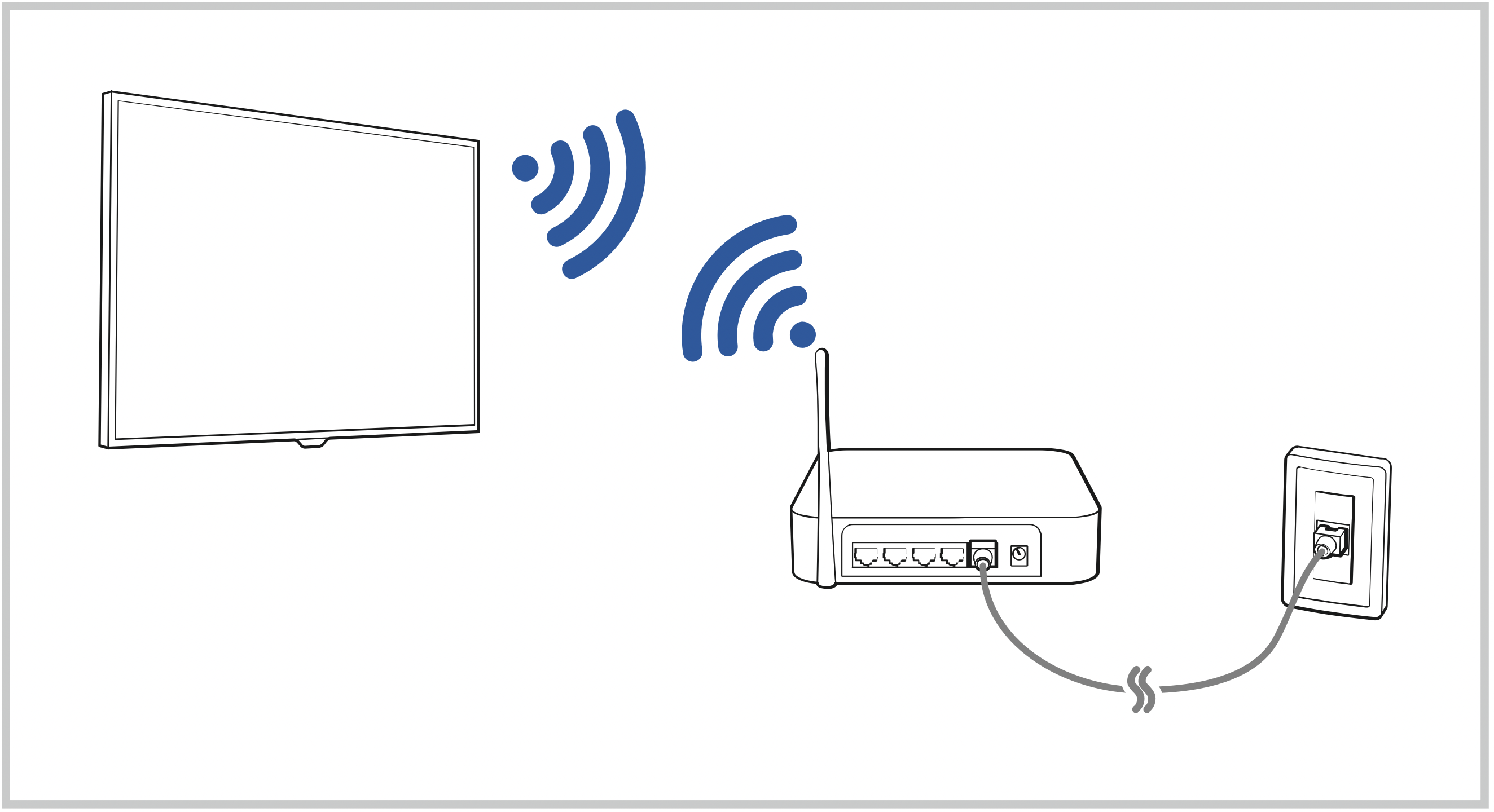
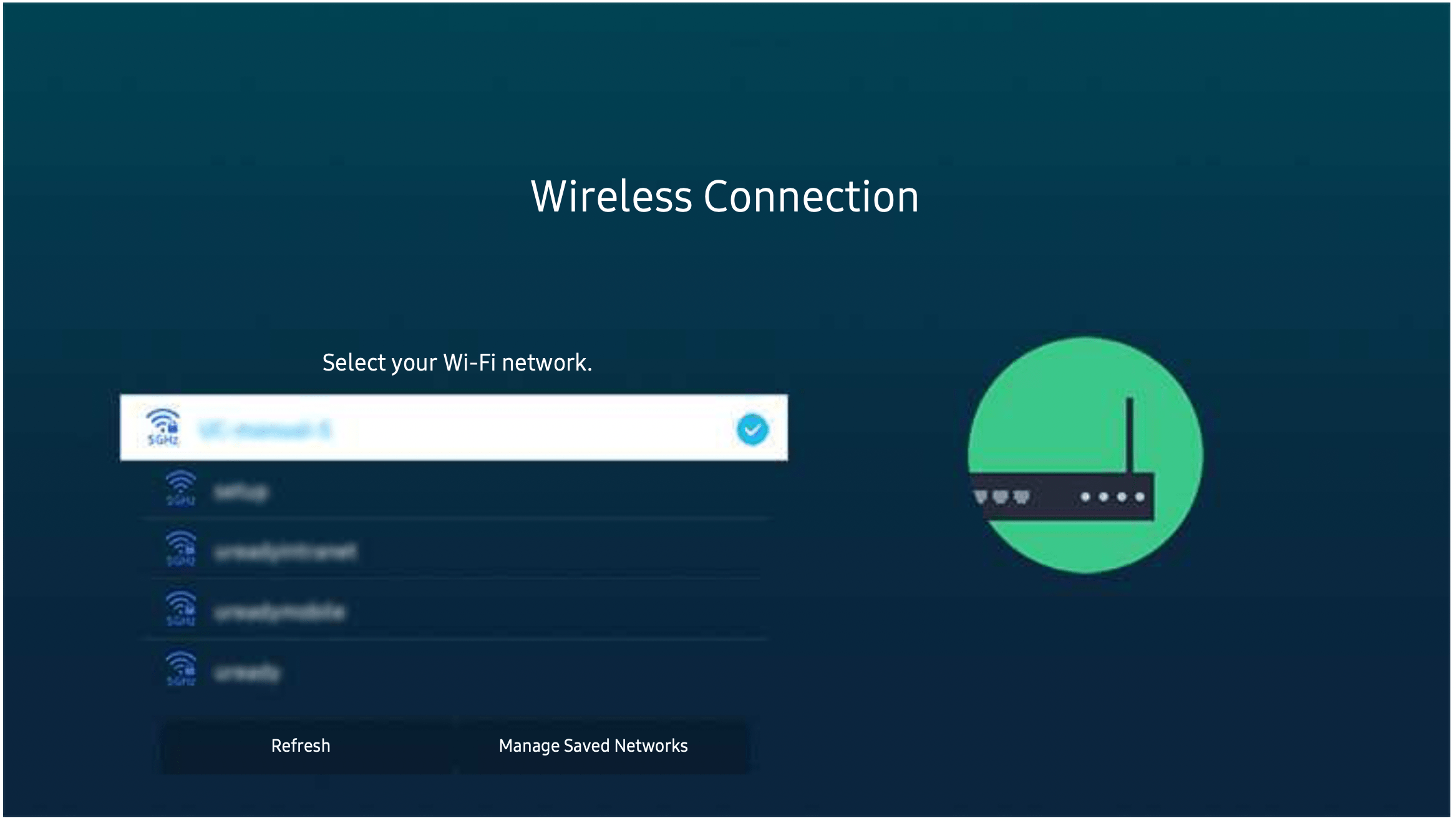
- The image on your TV may differ from the image above depending on the model and geographical area.
- If no wireless access point is found, select Add Network at the bottom of the list and enter the network name (SSID).
- If your wireless access point has a WPS or PBC button, select Use WPS at the bottom of the list, and then push the WPS or PBC button on your access point within 2 minutes. The TV will connect automatically.
- To view or delete previously connected network names (SSIDs), move the focus to Manage Saved Networks, and then press the Select button.
- To disconnect Wi-Fi, select Disconnect in
 >
>  Menu >
Menu >  Settings > All Settings > Connection > Network > Network Status.
Settings > All Settings > Connection > Network > Network Status.
Checking the network connection status
 >
>  Menu >
Menu >  Settings > All Settings > Connection > Network > Network Status.
Settings > All Settings > Connection > Network > Network Status.
View the current network status.
Resetting Your Network
 >
>  Menu >
Menu >  Settings > All Settings > Connection > Network > Reset Network.
Settings > All Settings > Connection > Network > Reset Network.
Restore the network settings to the factory default.
Turning on the TV with a mobile device
 >
>  Menu >
Menu >  Settings > All Settings > Connection > Network > Expert Settings > Power On with Mobile
Settings > All Settings > Connection > Network > Expert Settings > Power On with Mobile
You can turn on the TV using a mobile device connected to the same network as the TV.
- This function is available with a mobile device connected to the TV through the SmartThings app or the Apple AirPlay function.
- Apple AirPlay may not be supported depending on the model or geographical area.
Connecting an IP control device to the TV
 >
>  Menu >
Menu >  Settings > All Settings > Connection > Network > Expert Settings > IP Remote
Settings > All Settings > Connection > Network > Expert Settings > IP Remote
You can connect an IP control device to the TV remotely to manage your IP device.
- To use this function, Power On with Mobile must be turned on.
- Turning this feature on may allow other IP control devices to control your TV. We recommend turning this feature on only if an authorized third-party custom controller is installed and configured specifically for a Samsung TV and if your Wi-Fi network is password protected.
- This function may not be supported depending on the model.
Allowing to connect a wireless network
 >
>  Menu >
Menu >  Settings > All Settings > Connection > Network > Expert Settings > Wi-Fi
Settings > All Settings > Connection > Network > Expert Settings > Wi-Fi
You can enable the connection to Wi-Fi.
- To connect a wireless network, the function must be active.
Allowing to connect the Wi-Fi Direct
 >
>  Menu >
Menu >  Settings > All Settings > Connection > Network > Expert Settings > Wi-Fi Direct
Settings > All Settings > Connection > Network > Expert Settings > Wi-Fi Direct
When using Wi-Fi Direct, you can connect directly with other devices and share content without using a wireless router.
- To maximize the network performance when a 6 GHz access point is connected, turn off the Wi-Fi Direct function.
- This function may not be supported depending on the model.
Changing the name of the TV
 >
>  Menu >
Menu >  Settings > All Settings > Connection > Device Name
Settings > All Settings > Connection > Device Name
You can change the name of the TV on the network. Select User Input at the bottom of the list and change the name.
Connection Cables for External Devices
You can view detailed information about the connection cables for external devices that can be connected to the TV.
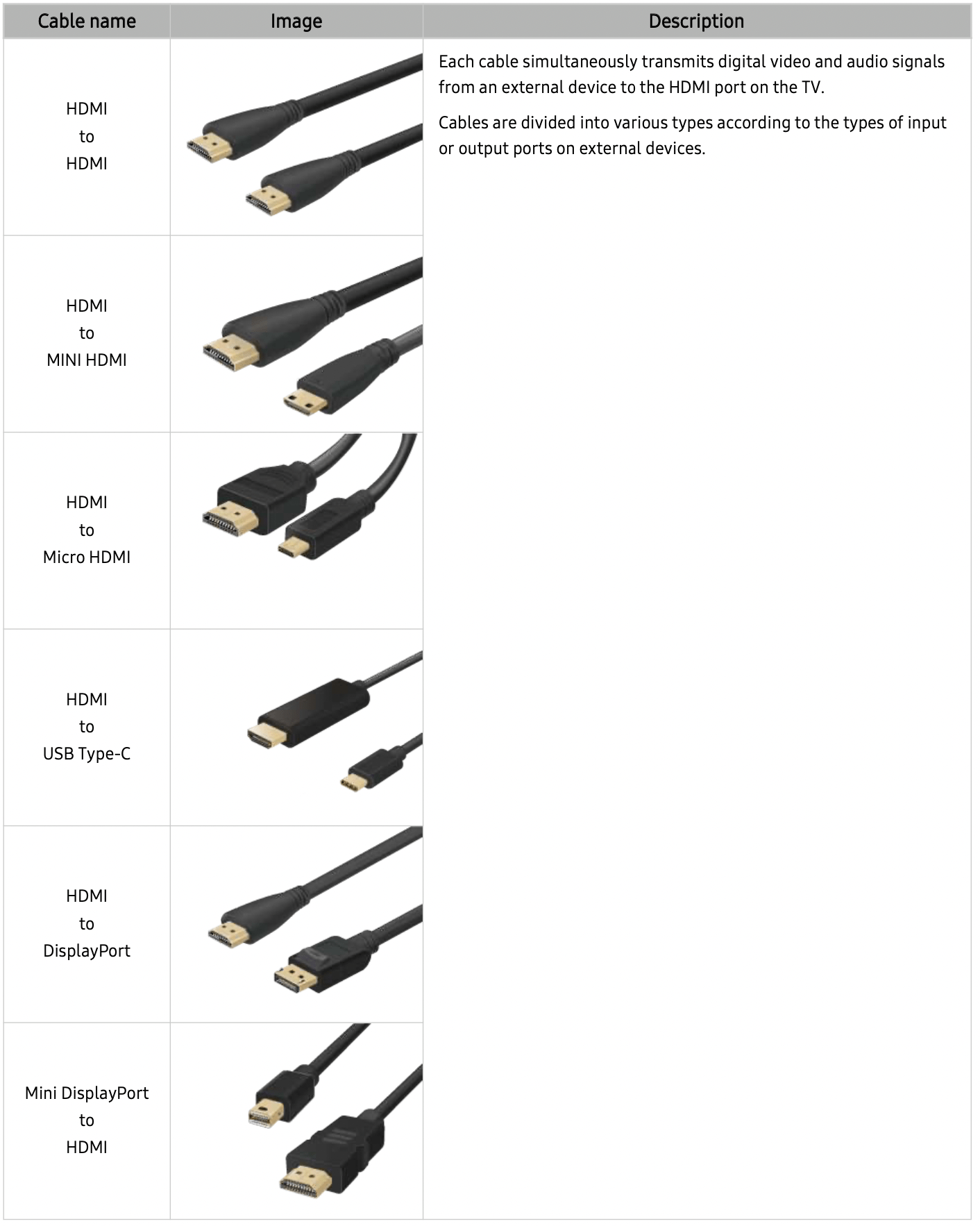
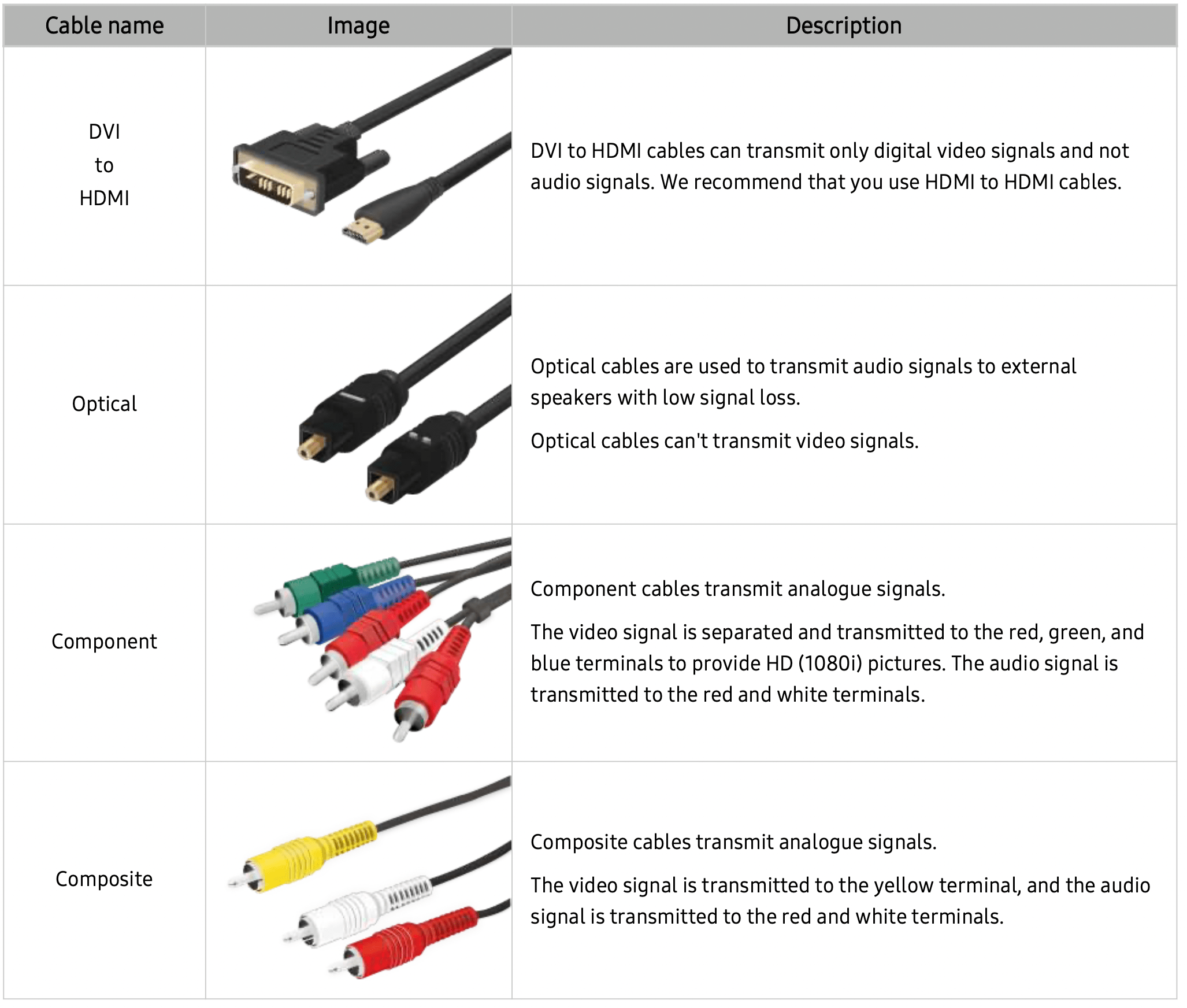
Remote Control and Peripherals
About the Samsung Smart Remote (QLED TV/The Frame (43-inch or larger models)/The Serif/OLED TV)
Learn about the buttons on the Samsung Smart Remote.


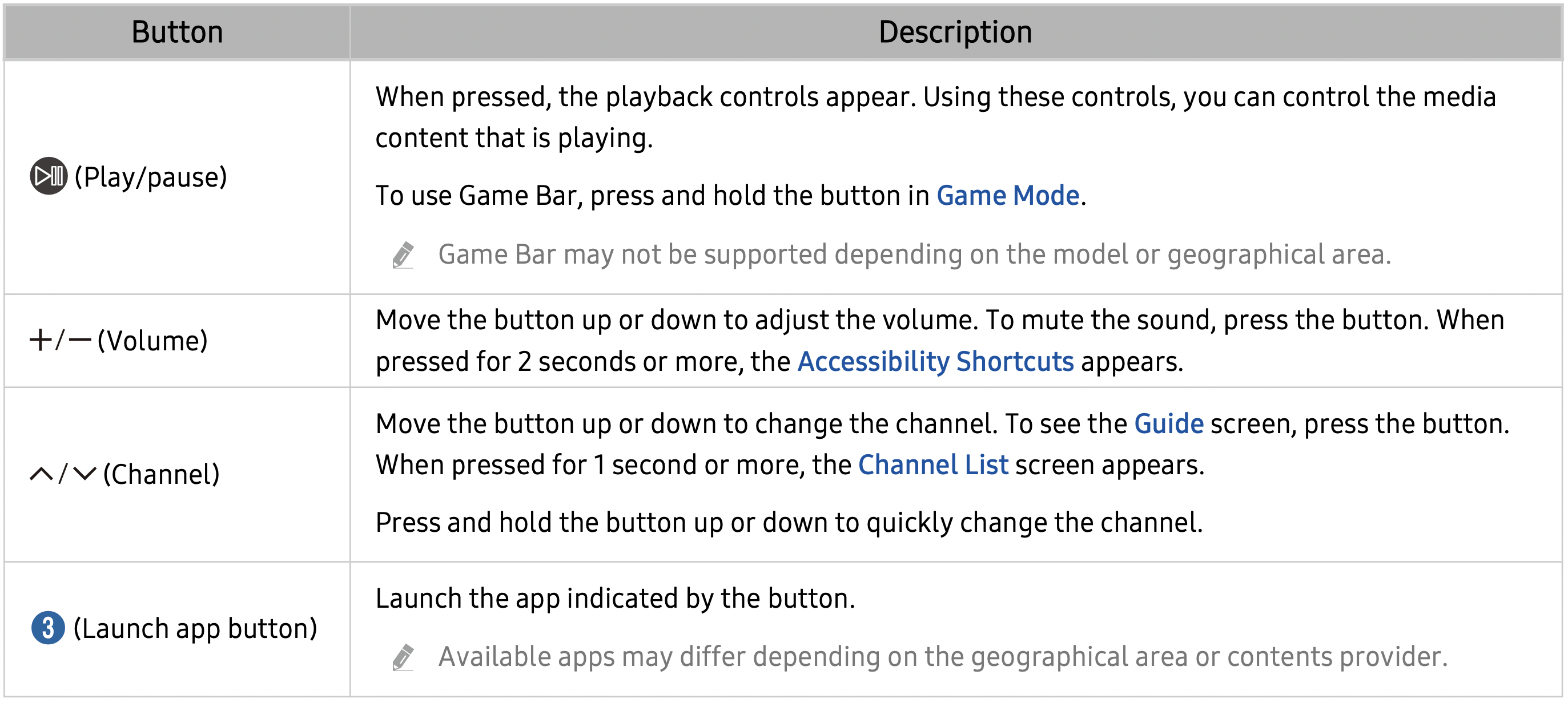
Note:
- Use the Samsung Smart Remote less than 20 feet (6 m) from the TV. The usable distance may vary with the wireless environmental conditions.
- The images, buttons, and functions of the Samsung Smart Remote may differ with the model or geographical area.
- To use the Samsung Smart Remote to control a compatible external device that does not support HDMI-CEC (Anynet+), you must configure universal remote control for the device. For more information, refer to "Controlling External Devices with a Samsung Remote Control - Using the Universal Remote."
- To use the Samsung Smart Remote to control a compatible external device that does support HDMI-CEC (Anynet+), connect the device to an HDMI port on the TV using an HDMI cable. For more information, refer to "Using Anynet+ (HDMI-CEC)."
About the Samsung Smart Remote (The Frame (32LS03B model)/BU8 Series)
Learn about the buttons on the Samsung Smart Remote.

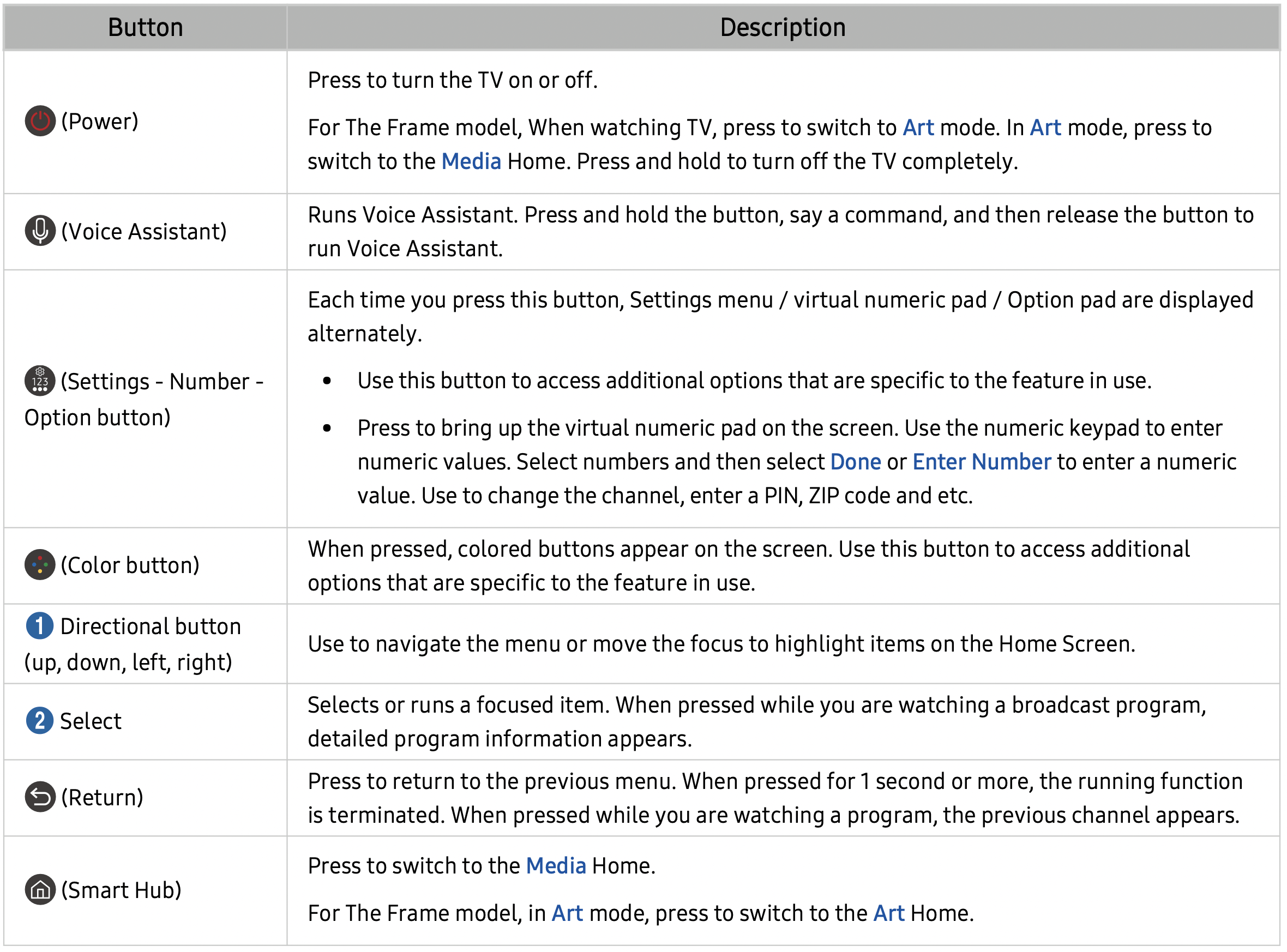
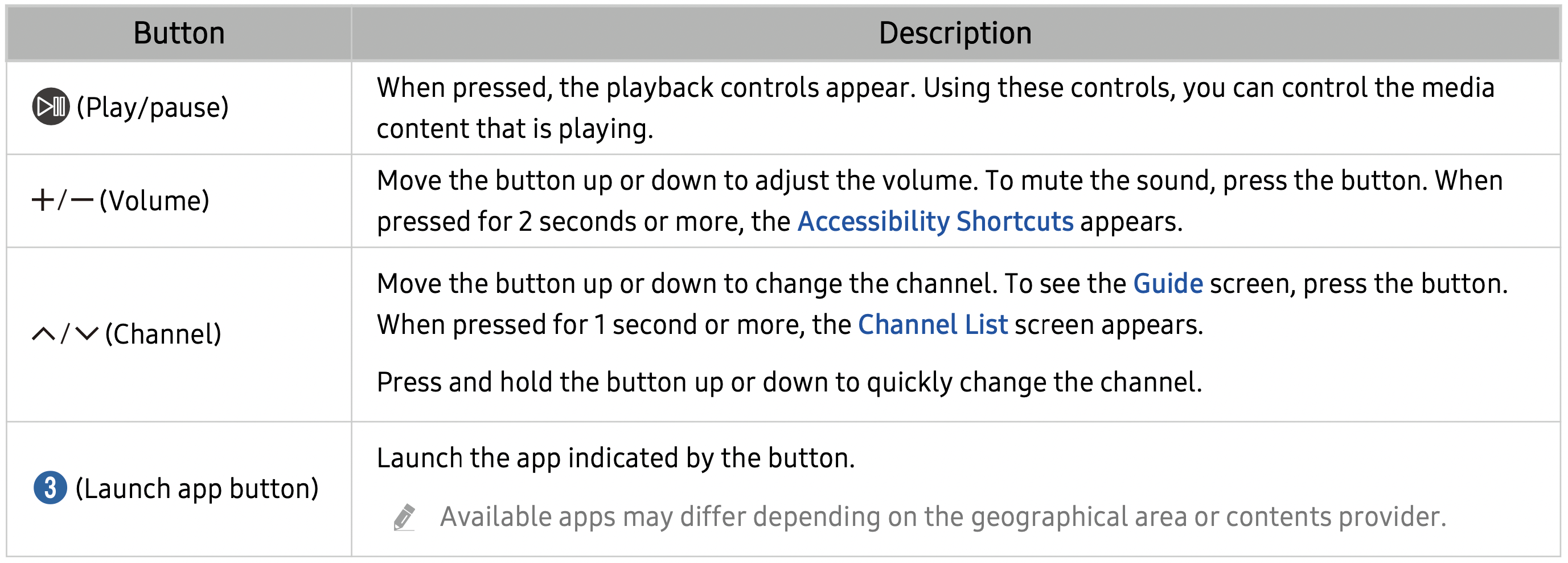
Note:
- Use the Samsung Smart Remote less than 20 feet (6 m) from the TV. The usable distance may vary with the wireless environmental conditions.
- The images, buttons, and functions of the Samsung Smart Remote may differ with the model or geographical area.
- To use the Samsung Smart Remote to control a compatible external device that does not support HDMI-CEC (Anynet+), you must configure universal remote control for the device. For more information, refer to "Controlling External Devices with a Samsung Remote Control - Using the Universal Remote."
- To use the Samsung Smart Remote to control a compatible external device that does support HDMI-CEC (Anynet+), connect the device to an HDMI port on the TV using an HDMI cable. For more information, refer to "Using Anynet+ (HDMI-CEC)."
About the Samsung Smart Remote (The Sero)

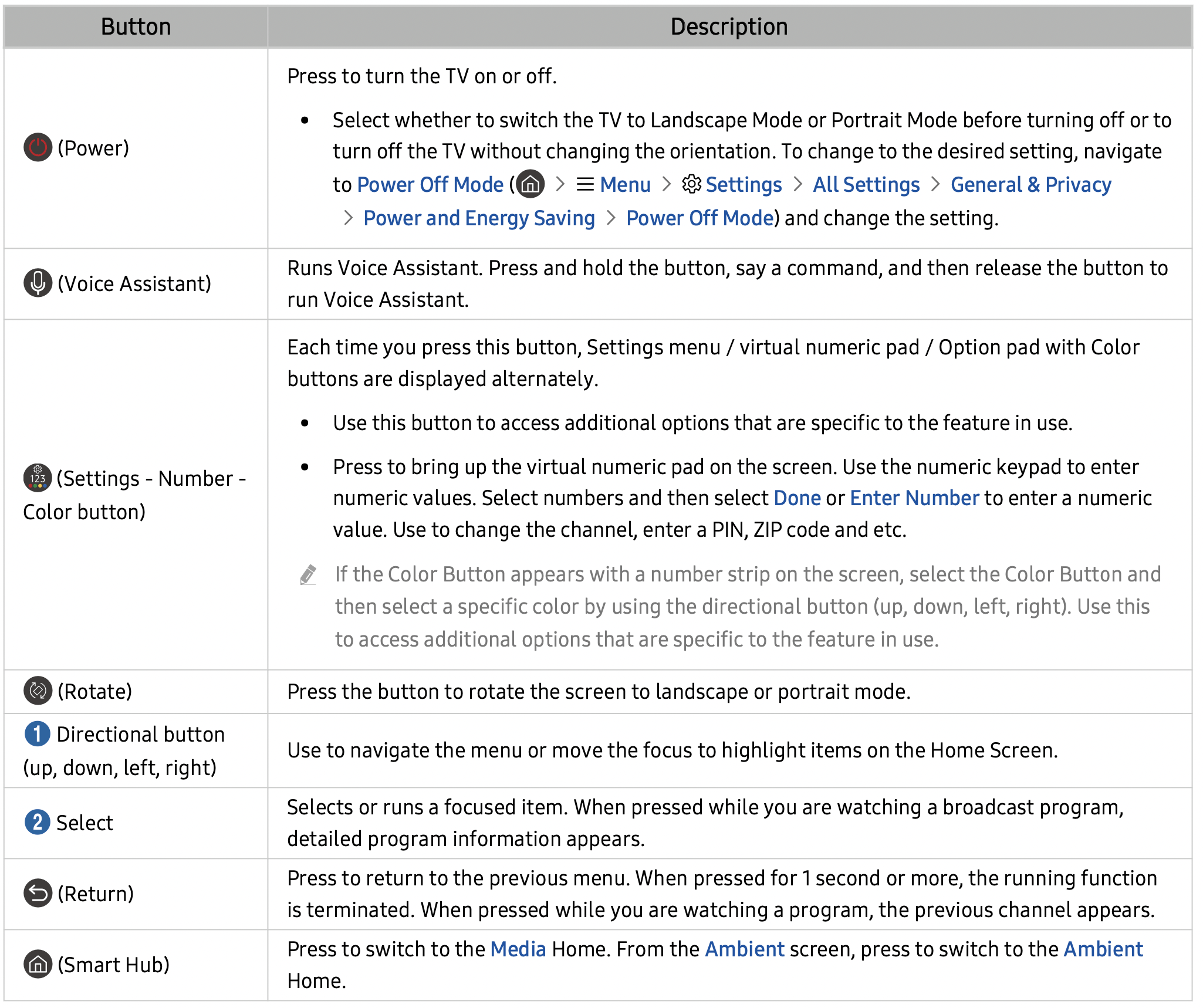
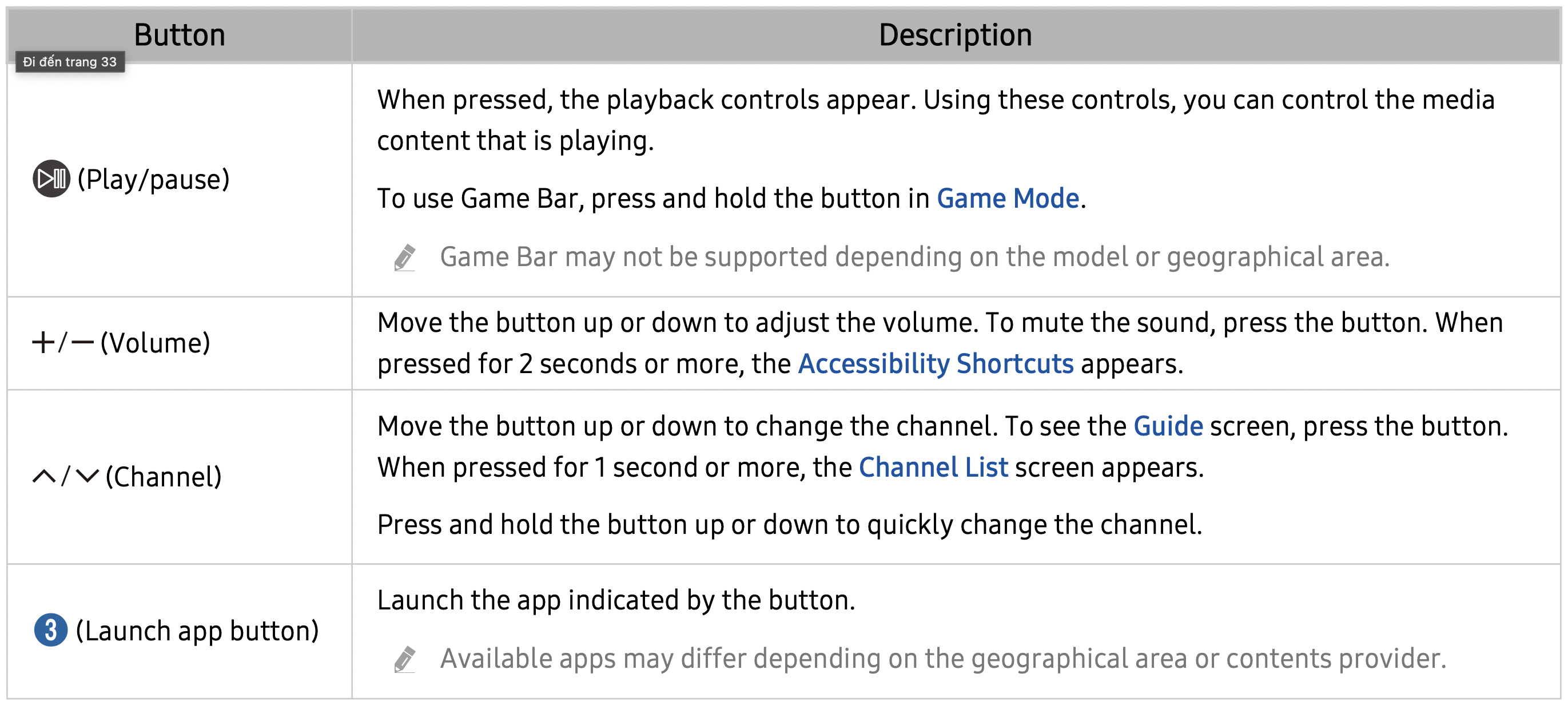
Note:
- Use the Samsung Smart Remote less than 20 feet (6 m) from the TV. The usable distance may vary with the wireless environmental conditions.
- The images, buttons, and functions of the Samsung Smart Remote may differ with the model or geographical area.
- To use the Samsung Smart Remote to control a compatible external device that does not support HDMI-CEC (Anynet+), you must configure universal remote control for the device. For more information, refer to "Controlling External Devices with a Samsung Remote Control - Using the Universal Remote."
- To use the Samsung Smart Remote to control a compatible external device that does support HDMI-CEC (Anynet+), connect the device to an HDMI port on the TV using an HDMI cable. For more information, refer to "Using Anynet+ (HDMI-CEC)."
Connecting the Samsung Smart Remote to the TV
Connect the Samsung Smart Remote to your TV to operate the TV.
When you turn on the TV for the first time, the Samsung Smart Remote pairs to the TV automatically. If the Samsung Smart Remote does not pair to the TV automatically, point it at the front of the TV, and then press and hold the  and
and  buttons simultaneously for 3 seconds or more.
buttons simultaneously for 3 seconds or more.
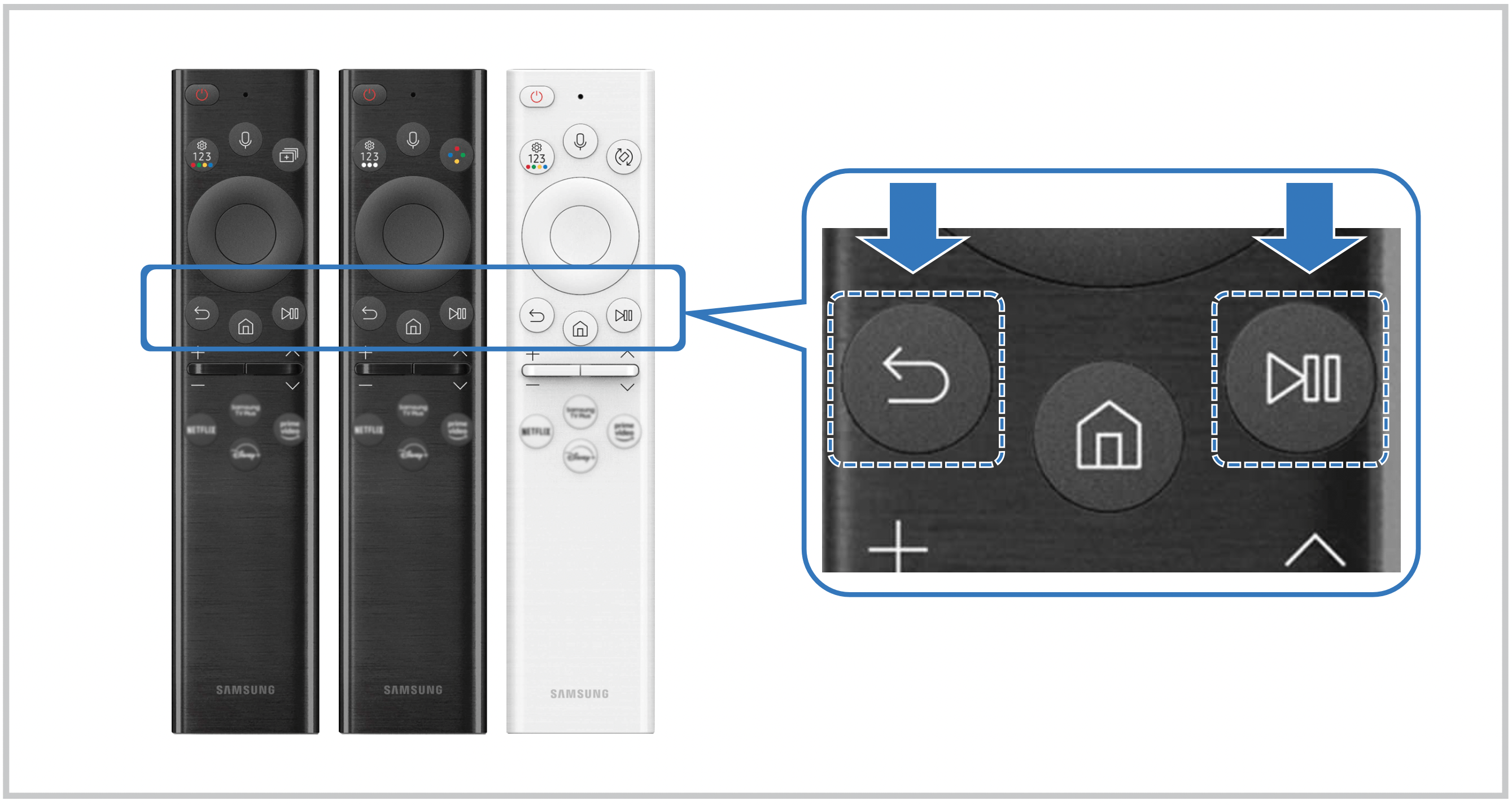
TV Viewing and Recording
Use a variety of convenience features offered by your Samsung TV while watching TV. You can also edit your list of channels and create a list of favorite channels.
Using the Guide
See the programming schedules of different channels on a single screen.
Press the  (channel) button to access the Guide.
(channel) button to access the Guide.
In the Guide, you can see the daily program schedules for each station, see program information, choose a program to watch, and set up a schedule viewing or recording.
- The Record function may not be supported depending on the model geographical area.
- To access information or additional features provided in the Guide from analog channels, you must set Service Provider during the initial configuration stage.
- To view Guide, you must first configure Clock (
 >
>  Menu >
Menu >  Settings > All Settings > General & Privacy > System Manager > Time > Clock).
Settings > All Settings > General & Privacy > System Manager > Time > Clock). - For details on how to use the remote control, refer to the image guide at the top right.
About the Guide screen
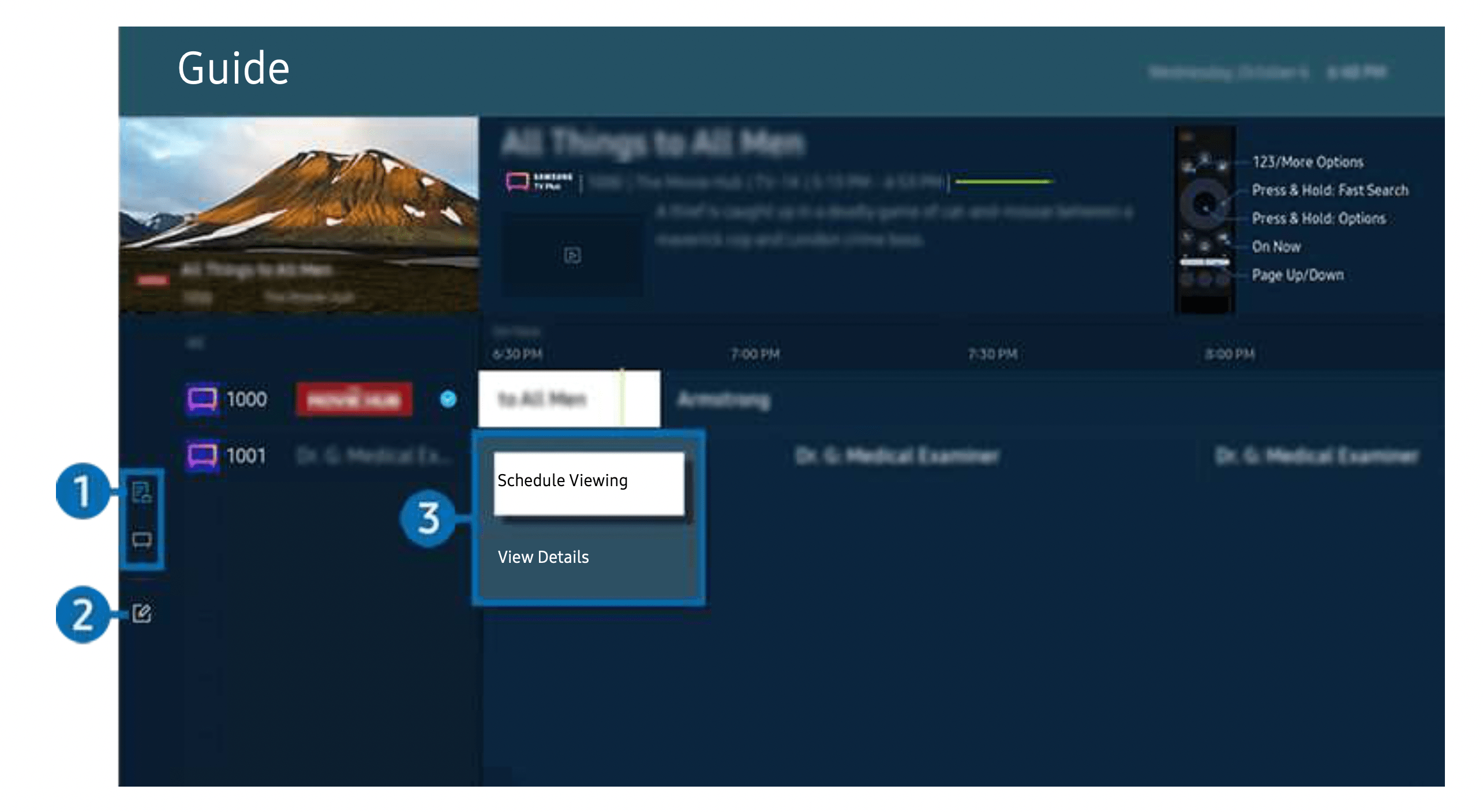
The image on your TV may differ from the image above depending on the model and geographical area.
- Channel Filter
View channels and programs classified by type. - Edit Channels
Edit channels stored on the TV.
See other models: SM-X200NZAEXAC SM-X200NZAAXAC SM-X200NZAEXSA SM-X205NZAEEUA SM-X205NZAAEUA
Note: For more information, refer to "Using the channel edit function." - Additional options related to broadcast programs
Navigate to the desired program and press and hold the Select button to access the following options:
Note: These functions may not be supported depending on the model or geographical area.
- Schedule Viewing
- You can schedule the viewing of a broadcast scheduled program.
- Cancel Scheduled Viewing
- You can cancel scheduled viewings.
- View Details
- You can see detailed information about the selected program. The information may differ or may not be provided depending on the broadcast signal.
- Record
- You can make a recording of a current program.
- Stop
- You can stop the recording function that is currently running.
- Edit Recording Time
- You can change the start and end times of scheduled program recordings.
- Schedule Recording
- You can schedule recording of a broadcast scheduled program.
- Cancel Scheduled Recording
- You can cancel scheduled recordings.
Using additional features from the Guide
From the Guide, press either the  or
or  button to use additional features.
button to use additional features.
Note: These functions may not be supported depending on the model or geographical area.
- Channel Filter
- You can view channels and programs categorized by the types defined in Channel List.
- Schedule Manager
- You can see the Recording & Schedule Manager or Schedule Manager screen.
- For more information about Schedule Recording, refer to "Recording Programs."
For more information about Schedule Viewing, refer to "Setting Up Schedule Viewing."
- For more information about Schedule Recording, refer to "Recording Programs."
- You can see the Recording & Schedule Manager or Schedule Manager screen.
- Antenna Type
- You can change the type of broadcast signals the TV receives.
Picture and Sound
Using the Sound Support Functions
Configure the sound settings for your TV.
Selecting speakers
 >
>  Menu >
Menu >  Settings > All Settings > Sound > Sound Output
Settings > All Settings > Sound > Sound Output
You can select which speakers the TV uses for audio output.
Note:
- If the sound bar is connected to the TV via both HDMI and Optical, HDMI may be selected first even if you select Optical.
- External speakers may not be controlled with the Samsung Smart Remote. When an external speaker is enabled, some sound menus are not supported.
Samsung TV supports the Q-Symphony function.
- This function works synchronized with the Samsung Soundbar that supports Q-Symphony so that your TV speaker and Soundbar simultaneously output the sound for best surround effects.
- When a Samsung Soundbar that supports Q-Symphony is connected, the menu name such as "TV + Soundbar" appears under Sound Output (
 >
>  Menu >
Menu >  Settings > All Settings > Sound > Sound Output). Select the menu.
Settings > All Settings > Sound > Sound Output). Select the menu.
Example) TV + [AV] Soundbar series name (HDMI) or TV + Optical
Note:
- It works based on the Codec supported by your TV. For more information about Codec information, refer to "Read Before Playing Photo, Video, or Music Files."
- This function is supported only when connected via HDMI, optical or Wi-Fi.
- This function may not be supported depending on the TV or Soundbar model.
- Refer to the sound bar's user manual when connecting it to the TV.
- This function is unavailable when using The Frame (32LS03B, 43LS03B) vertically. To use the product horizontally, set the function again.
Listening to the TV through Bluetooth devices
 >
>  Menu >
Menu >  Settings > All Settings > Sound > Sound Output > Bluetooth Speaker List
Settings > All Settings > Sound > Sound Output > Bluetooth Speaker List
You can connect Bluetooth audio devices to the TV. They must be paired using the TV's Bluetooth function. Refer to the user manual for your audio device such as Bluetooth speaker, sound bar, and headphones for detailed connection and usage.
Note:
- If the TV fails to find a Bluetooth audio device, place the device closer to the TV, and then select Refresh.
- When you turn on a paired Bluetooth audio device, the TV detects it automatically, and then displays a pop-up window. Use this pop-up window to activate or deactivate the Bluetooth audio device.
- The sound quality may be affected by the condition of the Bluetooth connection.
- Before using a Bluetooth audio device, refer to "Read Before Using Bluetooth Devices."
- On some models, you can connect and use two Bluetooth devices simultaneously.
Listening to the TV through a Samsung audio device that supports the Wi-Fi function
 >
>  Menu >
Menu >  Settings > All Settings > Sound > Wi-Fi Speaker Surround Setup
Settings > All Settings > Sound > Wi-Fi Speaker Surround Setup
If you've connected one or more Samsung wireless audio devices that support the Wi-Fi function to the TV, you can create an optimal sound set up by configuring the surround effect settings. You can select any of the surround sound configurations, with or without a sound bar.
A surround sound configuration can be used if all of the following conditions are met:
- Two or more Samsung wireless speakers of the same type must be connected to the same wireless network.
- The Samsung audio devices that support the Wi-Fi function must be connected to the same wireless network as the TV.
Note:
- For more information about how to connect and use a Samsung audio device that supports the Wi-Fi function, refer to its user manual.
- Surround sound configurations with a sound bar may not be supported depending on the product.
- If you activate the Screen Mirroring function while using Samsung audio devices that support the Wi-Fi function, the Wi-Fi connection is disconnected.
- Mismatched video and audio lip-syncing may occur depending on the device type.
Troubleshooting
The following are troubleshooting solutions for each problem.
Picture Issues
When the TV has trouble with the picture, these steps may help resolve the problem.
The screen is flashing or has become dark
If your TV is flickering or dimming sporadically, you may need to disable some of the energy efficiency features.
Disable Brightness Optimization, Brightness Reduction, Motion Lighting, or Contrast Enhancer.
 >
>  Menu >
Menu >  Settings > All Settings > General & Privacy > Power and Energy Saving > Brightness Optimization
Settings > All Settings > General & Privacy > Power and Energy Saving > Brightness Optimization >
>  Menu >
Menu >  Settings > All Settings > General & Privacy > Power and Energy Saving > Brightness Reduction
Settings > All Settings > General & Privacy > Power and Energy Saving > Brightness Reduction >
>  Menu >
Menu >  Settings > All Settings > General & Privacy > Power and Energy Saving > Motion Lighting
Settings > All Settings > General & Privacy > Power and Energy Saving > Motion Lighting >
>  Menu >
Menu >  Settings > All Settings > Picture > Expert Settings > Contrast Enhancer
Settings > All Settings > Picture > Expert Settings > Contrast Enhancer
Run Picture Test. When the tested image quality is normal, check the signal of the connected device.
 >
>  Menu >
Menu >  Settings > Support > Device Care > Self Diagnosis > Picture Test
Settings > Support > Device Care > Self Diagnosis > Picture Test
The picture is not bright, or the picture colors do not look clear
If the screen appears too dim, try changing the settings under Reset Picture or disabling Brightness Optimization, Brightness Reduction.
 >
>  Menu >
Menu >  Settings > All Settings > Picture > Expert Settings > Reset Picture
Settings > All Settings > Picture > Expert Settings > Reset Picture >
>  Menu >
Menu >  Settings > All Settings > General & Privacy > Power and Energy Saving > Brightness Optimization
Settings > All Settings > General & Privacy > Power and Energy Saving > Brightness Optimization >
>  Menu >
Menu >  Settings > All Settings > General & Privacy > Power and Energy Saving > Brightness Reduction
Settings > All Settings > General & Privacy > Power and Energy Saving > Brightness Reduction
Go to Picture and adjust the Picture Mode, Contrast, Brightness, and Sharpness settings.
 >
>  Menu >
Menu >  Settings > All Settings > Picture > Picture Mode
Settings > All Settings > Picture > Picture Mode >
>  Menu >
Menu >  Settings > All Settings > Picture > Expert Settings > Contrast
Settings > All Settings > Picture > Expert Settings > Contrast >
>  Menu >
Menu >  Settings > All Settings > Picture > Expert Settings > Brightness
Settings > All Settings > Picture > Expert Settings > Brightness >
>  Menu >
Menu >  Settings > All Settings > Picture > Expert Settings > Sharpness
Settings > All Settings > Picture > Expert Settings > Sharpness >
>  Menu >
Menu >  Settings > All Settings > Picture > Expert Settings > Color
Settings > All Settings > Picture > Expert Settings > Color >
>  Menu >
Menu >  Settings > All Settings > Picture > Expert Settings > Tint (G/R)
Settings > All Settings > Picture > Expert Settings > Tint (G/R)
The picture colors are black and white or do not look the way they should look
If the product’s colors or absolute whites/blacks seem to be off, launch Picture Test.
 >
>  Menu >
Menu >  Settings > Support > Device Care > Self Diagnosis > Picture Test
Settings > Support > Device Care > Self Diagnosis > Picture Test
If the test results indicate that the problem is not caused by the TV, do the following:
When using the One Connect Box, confirm that its video input connectors are connected to the correct externaldevice video output connectors.
If using a component cable, ensure that the green (Y), blue (Pb), and red (Pr) cables are connected properly.
Incorrect connections may cause color problems or a blank screen.
Note: Component port may not be supported depending on the model.
Check whether Grayscale is set to On.
 >
>  Menu >
Menu >  Settings > All Settings > General & Privacy > Accessibility > Grayscale
Settings > All Settings > General & Privacy > Accessibility > Grayscale
The TV automatically turns off by itseft
If your TV appears to turn off by itself, try disabling some of the TV's energy efficiency functions.
See if Sleep Timer has been enabled. The Sleep Timer automatically turns the TV off after a specified period of time.
 >
>  Menu >
Menu >  Settings > All Settings > General & Privacy > System Manager > Time > Sleep Timer
Settings > All Settings > General & Privacy > System Manager > Time > Sleep Timer
If the Sleep Timer has not been enabled, see if Auto Power Off or Off Timer has been enabled and disable it.
 >
>  Menu >
Menu >  Settings > All Settings > General & Privacy > Power and Energy Saving > Auto Power Off
Settings > All Settings > General & Privacy > Power and Energy Saving > Auto Power Off >
>  Menu >
Menu >  Settings > All Settings > General & Privacy > System Manager > Time > Off Timer
Settings > All Settings > General & Privacy > System Manager > Time > Off Timer
TV (The Frame TV) cannot be turned off.
If your TV is The Frame model, you can turn off the TV by long-pressing the Power button. To switch from Art mode to TV mode or vice versa, short-press the Power button when the TV is on.
Unable to power on
- If you are having problems powering on your TV, there are a number of things to check before calling the service department.
- Confirm that the TV's power cord is connected correctly at both ends and that the remote control is operating normally.
- Make sure that the antenna cable or cable TV cable is firmly connected.
- If you have a cable box or satellite box, confirm that it is plugged in and turned on.
- In case of a model that supports One Connect Box, check the One Invisible Connection or One Connect Cable between the TV and One Connect Box.
The TV remains on or does not turn on automatically.
If the surrounding area is too dark or bright, the motion sensor may not work normally. The performance of the motion sensor may be affected by the installation environment (height, tilt, obstacles). If the clothes you wear or your skin color is similar to the surrounding shading, the motion sensor may not work properly.
Note: Motion Sensor may not be supported depending on the model or geographical area.
The TV responds to all visual changes around it (lights, displays, dogs, out-of-window changes, and other occurrences). You can adjust the response level by adjusting the sensitivity of the motion detector.
 > left directional button >
> left directional button >  Art > Art Mode Options > Motion Detector
Art > Art Mode Options > Motion Detector
Note:
- Art Mode Options can be found at the bottom of the Art home. To configure the option settings, scroll down to the far bottom.
- Motion Detector may not be supported depending on the model or geographical area.
Unable to find a Channel
If your TV is not connected to a cable box or satellite box, run Auto Program.
 >
>  Menu >
Menu >  Settings > All Settings > Broadcasting > Auto Program
Settings > All Settings > Broadcasting > Auto Program
When using a broadcast receiver such as set-top box and IPTV, check the connection to the TV.
 >
>  Menu >
Menu >  Connected Devices > Connection Guide
Connected Devices > Connection Guide
When the symptom persists, contact your service provider.
The TV image does not look as good as it did in the store
Store displays are tuned to a digital UHD channel or HD channel.
Change the output resolution of your devices, such as digital broadcast receiver, IPTV, and set-top box to UHD or HD.
Be sure to use an HDMI cable to enjoy high quality videos.
 >
>  Menu >
Menu >  Connected Devices > Connection Guide > Video Device > HDMI
Connected Devices > Connection Guide > Video Device > HDMI
To connect the TV with your PC, make sure that your PC's graphic card supports UHD resolutions.
For more information about the supported UHD resolutions, refer to "Supported Resolutions for UHD Input Signals."
For more information about the supported 8K resolutions, refer to "Resolutions for Input Signals supported by 8K models (QN7**B series or higher)."
Note:
- Make sure that the set-top box or cable box supports the content or broadcast for UHD and set the resolution. For more information, contact your service provider.
- When using a Samsung TV Plus channel, check the network connection. When the network speed is slow, the app may not work or the image quality may be poor.
Displayed video looks blurry
If you notice blurring or juddering on the screen, use the Picture Clarity Settings function to resolve the issue.
 >
>  Menu >
Menu >  Settings > All Settings > Picture > Expert Settings > Picture Clarity Settings.
Settings > All Settings > Picture > Expert Settings > Picture Clarity Settings.
The picture is distorted
The compression of video content may cause picture distortions, especially in fast moving pictures from sports programs and action movies.
Remove and reconnect the power cord, and check the remote control battery.
If the signal reception is weak or poor, screen distortion may be visible but it is not a malfunction.
Mobile phones used close to the TV (within 3.2 ft) may cause noise on analog and digital channels.
There is a dotted line on the edge of the screen
Change Picture Size to 16:9 Standard.
 >
>  Menu >
Menu >  Settings > All Settings > Picture > Picture Size Settings > Picture Size
Settings > All Settings > Picture > Picture Size Settings > Picture Size
Change the output resolution of your external device.
The picture won’t display in full screen
HD channels will have black bars on either side of the screen when displaying upscaled SD (4:3) content.
Black bars will appear at the top and bottom of the screen when you watch movies that have aspect ratios different from your TV.
Adjust the picture size options on your external device or set the TV to full screen.
 >
>  Menu >
Menu >  Settings > All Settings > Picture > Picture Size Settings > Picture Size
Settings > All Settings > Picture > Picture Size Settings > Picture Size
The Caption function in the TV menu is deactivated
When an external device is connected with an HDMI or Component cable, the Caption function is unavailable. Adjust the caption setting on the external device.
Captions appear on the TV screen
Turn off the Caption function in Caption Settings.
 >
>  Menu >
Menu >  Settings > All Settings > General & Privacy > Accessibility > Caption Settings > Caption
Settings > All Settings > General & Privacy > Accessibility > Caption Settings > Caption
The HDR of the connected external device turns off
Expand the reception range of the corresponding HDMI input signal in Input Signal Plus.
 >
>  Menu >
Menu >  Settings > All Settings > Connection > External Device Manager > Input Signal Plus
Settings > All Settings > Connection > External Device Manager > Input Signal Plus
Sound and Noise Issues
When the TV has difficulties with sound, these steps may help resolve the problem.
How can I connect an audio device to the TV?
The connection method may differ depending on the audio device, such as HDMI (eARC), Optical, Bluetooth, and Wi-Fi.
For more information about how to connect an audio device, run Connection Guide.
 >
>  Menu >
Menu >  Connected Devices > Connection Guide > Audio Device
Connected Devices > Connection Guide > Audio Device
There is no sound or the sound is too low at maximum volume.
Check the volume control of your TV, and then check the volume control of the external device (cable box or satellite box, DVD, Blu-ray, etc.) connected to your TV.
Check the cable connection between an external device and the TV and then try cable connection again.
The picture is good but there is no sound.
Check the Sound Output setting. If it is set to TV Speaker, check the volume setting.
 >
>  Menu >
Menu >  Settings > All Settings > Sound > Sound Output
Settings > All Settings > Sound > Sound Output- If you are using an external device, check the device’s audio output option.
- For example, you may need to change your cable box’s audio option to HDMI if the box connected to your TV is using an HDMI cable.
- To listen to computer sound, connect an external speaker to the computer’s audio output connector.
- If your TV has a headphone jack, make sure there is nothing plugged into it.
- Reboot the connected device by disconnecting and then reconnecting the device’s power cable.
- With a set-top box or cable box, check the cable connection and reboot the external device. When the symptom persists, contact your service provider.
HDMI (eARC) is connected, and there is no sound.
Check whether Digital Output Audio Format is set to Pass-Through.
If a sound bar or A/V receiver that does not support Dolby Digital+ is used and Pass-Through is selected, there is no sound when a Dolby Digital+ source is received.
It is recommended to set Digital Output Audio Format to Auto if only limited audio format is supported depending on the performance of the connected sound bar or A/V receiver.
 >
>  Menu >
Menu >  Settings > All Settings > Sound > Expert Settings > Digital Output Audio Format > Auto
Settings > All Settings > Sound > Expert Settings > Digital Output Audio Format > Auto
The speakers are making an odd sound.
Run Sound Test.
 >
>  Menu >
Menu >  Settings > Support > Device Care > Self Diagnosis > Sound Test
Settings > Support > Device Care > Self Diagnosis > Sound Test
Make sure that the audio cable is connected to the correct audio output connector on the external device.
For antenna or cable connections, check the Signal Information. A low signal level may cause sound distortions.
 >
>  Menu >
Menu >  Settings > Support > Device Care > Self Diagnosis > Signal Information
Settings > Support > Device Care > Self Diagnosis > Signal Information
The sound is interrupted.
- Sound quality may become affected if the wireless router is close to the Bluetooth speaker. Place the Bluetooth speaker as close as possible to the TV without obstacle between them. Do not place the wireless router close to the Bluetooth speaker body.
- To minimize interruptions, we recommend a wireless access point that uses a 5 GHz frequency. 5 GHz may not be available depending on the model.
- When the symptom persists, it is recommended to use wired connection such as HDMI (eARC) and Optical.
Whenever a function is used on the TV or the channel is changed, the TV voices the activity. The TV explains in voice-over the video scenes displayed on the screen.
Turn off the Voice Guide function in Voice Guide Settings.
 >
>  Menu >
Menu >  Settings > All Settings > General & Privacy > Accessibility > Voice Guide Settings > Voice Guide
Settings > All Settings > General & Privacy > Accessibility > Voice Guide Settings > Voice Guide
The TV audio is not being played through the Sound bar or A/V receiver.
Check the Sound bar or A/V receiver's power supply and its settings.
- When connecting the optical cable between the TV and Sound bar or A/V receiver, make sure that the sound output is set Optical on your TV.
- In case of HDMI eARC connection, make sure that it is connected to the eARC dedicated HDMI port on your TV.
However, the eARC can be used only when the Sound bar or A/V receiver supports the eARC feature.
The sound is not heard clearly.
Change to an appropriate sound mode.
 >
>  Menu >
Menu >  Settings > All Settings > Sound > Sound Mode
Settings > All Settings > Sound > Sound Mode
When Intelligent Mode and Adaptive Sound+ are turned on, the sound effects are automatically adjusted to the surroundings.
 >
>  Menu >
Menu >  Settings > All Settings > General & Privacy > Intelligent Mode Settings > Intelligent Mode
Settings > All Settings > General & Privacy > Intelligent Mode Settings > Intelligent Mode
Note: This function may not be supported depending on the model.
To optimize the sound depending on the surroundings, select Adaptive Sound+.
 >
>  Menu >
Menu >  Settings > All Settings > General & Privacy > Intelligent Mode Settings > Adaptive Sound+
Settings > All Settings > General & Privacy > Intelligent Mode Settings > Adaptive Sound+
Note: This function may not be supported depending on the model.
The volume of the external device cannot be adjusted.
Check the cable connection between the TV and the external device.
When connecting an external speaker such as home theater via HDMI, make sure it is connected to the HDMI (eARC) port on the TV. Make sure that the  >
>  Menu >
Menu >  Settings > All Settings > Connection > External Device Manager > Anynet+ (HDMI-CEC) is active on your TV.
Settings > All Settings > Connection > External Device Manager > Anynet+ (HDMI-CEC) is active on your TV.
Note: If a device is connected via Optical, volume control may not be possible, depending on the device.
I want to turn the TV and audio device off and on at the same time.
When you connect the Samsung Soundbar to the TV via Bluetooth, the power turns off and on together. It may not be supported depending on the Samsung Soundbar model.
When you connect an audio device that supports HDMI eARC to the HDMI (eARC) port on the TV, the power turns off and on together.
Channel and Broadcast Issues
When the TV has difficulties receiving broadcasts, these steps may help resolve the problem.
"Weak or No Signal" displayed in TV mode or cannot find channel.
Make sure that the external device is connected securely and turned on. Move to Connected Devices to switch to other input sources.
 >
>  Menu >
Menu >  Connected Devices > Sources
Connected Devices > Sources
When using a set-top box or cable box, check the broadcast signals or the network that is connected to the external device.
The TV is not receiving all channels.
Confirm that the coaxial cable is securely connected to the TV.
Run Reset or Auto Program.
 >
>  Menu >
Menu >  Settings > All Settings > General & Privacy > Reset
Settings > All Settings > General & Privacy > Reset >
>  Menu >
Menu >  Settings > All Settings > Broadcasting > Auto Program
Settings > All Settings > Broadcasting > Auto Program
The captions are not provided on a digital channel.
When watching channels with the antenna cable connected, run Caption Settings.
 >
>  Menu >
Menu >  Settings > All Settings > General & Privacy > Accessibility > Caption Settings
Settings > All Settings > General & Privacy > Accessibility > Caption Settings
Some channels may not have caption data.
When watching a channel on an external device such as a set-top box and cable box, turn on the caption function on the device. For more information, contact your service provider.
Broadcasting is deactivated.
Broadcasting is only available when Source is set to TV.
Broadcasting cannot be accessed while you watch TV using a cable box or satellite box.
Broadcasting cannot be accessed while a recording is in progress or the Timeshift function is running.
External Device Connectivity Issues
When the TV has difficulties connecting to external devices such as a PC, game console, or mobile device, these steps may help resolve the problem.
The "Mode Not Supported" message appears.
Adjust the output resolution of the external device to a resolution supported by the TV.
The video is OK but there is no audio.
If you are using an HDMI connection, check the audio output setting on your PC.
If you are using a DVI to HDMI cable, a separate audio cable is required.
To listen to the computer sound, connect external speakers to the audio output connection of the computer.
I want to connect to a PC and mobile device via screen mirroring.
To wirelessly connect the TV to your PC, read the instructions at PC > Screen Sharing (Wireless) in Connection Guide, and then try to connect.
 >
>  Menu >
Menu >  Connected Devices > Connection Guide > PC > Screen Sharing (Wireless)
Connected Devices > Connection Guide > PC > Screen Sharing (Wireless)
Confirm that the TV and your PC are connected to the same network.
To wirelessly connect the TV to your mobile device, read the instructions at Smartphone Screen Sharing (Smart View) in Connection Guide, and then try to connect.
 >
>  Menu >
Menu >  Connected Devices > Connection Guide > Smartphone > Screen Sharing (Smart View)
Connected Devices > Connection Guide > Smartphone > Screen Sharing (Smart View)
If the TV has difficulties connecting to your PC or mobile device due to surrounding radio interferences, change the frequency of the wireless access band, and then try to connect.
No screen appears when connecting the TV to an external device.
For more information about how to connect an external device, run Connection Guide.
 >
>  Menu >
Menu >  Connected Devices > Connection Guide
Connected Devices > Connection Guide
Make sure that the external device is connected securely and turned on. Move to Sources to switch to other input sources.
 >
>  Menu >
Menu >  Connected Devices > Sources
Connected Devices > Sources
Using HDMI Troubleshooting, you can check the connection to HDMI cable and external devices (takes approximately 2 minutes).
 >
>  Menu >
Menu >  Connected Devices > Connection Guide > Video Device > HDMI Troubleshooting
Connected Devices > Connection Guide > Video Device > HDMI Troubleshooting
When using a set-top box or cable box, check the broadcast signals or the network that is connected to the external device.
I want to connect to a Bluetooth speaker.
For more information on how to connect a Bluetooth speaker, see Audio Device > Bluetooth in Connection Guide.
 >
>  Menu >
Menu >  Connected Devices > Connection Guide > Audio Device > Bluetooth
Connected Devices > Connection Guide > Audio Device > Bluetooth
The PC screen does not appear or it flickers.
When the PC screen does not appear or the PC is not recognized, check the power supply of the PC and then reconnect the HDMI cable between the PC and TV. When the symptom persists, check that the PC is in Sleep mode and then set Input Signal Plus to On.
 >
>  Menu >
Menu >  Settings > All Settings > Connection > External Device Manager > Input Signal Plus
Settings > All Settings > Connection > External Device Manager > Input Signal Plus
When the set resolution is not matched, it may cause a blank or flickering screen. For the PC supported resolution, see "Read Before Connecting a Computer (Supported Resolutions)."
Network Issues
When the TV has difficulties connecting to the network, these steps may help resolve the problem.
Wireless network connection failed. Unable to connect to a wireless access point. Unable to connect to the network.
 >
>  Menu >
Menu >  Settings > Support > Device Care > Self Diagnosis > Smart Hub Connection Test
Settings > Support > Device Care > Self Diagnosis > Smart Hub Connection Test
- Ensure that the network cable is connected and the router is powered on.
- Connect your mobile device to the router via Wi-Fi.
- Turn the router off and back on again. (Requires 2 to 3 minutes)
- If a security key is required, make sure it has been entered correctly.
- Unplug the TV’s power cord and plug it back in or long-press the power button for at least 3 seconds.
- Make sure that there is no electromagnetic wave generating device placed between the TV and router.
- If unable to establish a wireless internet connection, connect the TV to the wireless router via an LAN cable.
- If the TV is able to connect to the internet normally via the cable connection, there might be a problem with the wireless router. In this case, try using a different wireless router.
Note: Wired networks are not supported by some models.
Wired network connection failed.
Check if the LAN cable is plugged in on both ends. If it is plugged in, check if the access point is turned on. If it is on, turn it off, wait 1 or 2 minutes, and then turn it on.
Note: Wired networks are not supported by some models.
Connected to a local network, but not to the Internet.
Connected to a local network, but not to the Internet.
Note: Wired networks are not supported by some models.
- Check if the Internet LAN cable is connected to the access point's external LAN port.
- Check the DNS setting in IP Settings.
 >
>  Menu >
Menu >  Settings > All Settings > Connection > Network > Network Status > IP Settings
Settings > All Settings > Connection > Network > Network Status > IP Settings
Anynet+ (HDMI-CEC) Issues
When Anynet+ (HDMI-CEC) isn't working, these steps may help resolve the problem.
What is Anynet+?
You can use the TV's remote control to control external devices that support Anynet+ (HDMI-CEC) and that are connected to the TV via an HDMI cable. For example, if a connected external device supports Anynet+, you can have the connected device turn on or off when you turn the TV on or off.
Anynet+ does not work. The connected device is not displayed.
Make sure the device is an Anynet+ (HDMI-CEC) device. From the settings menu on the device, check and confirm that the HDMI-CEC option is enabled.
From the TV, check and confirm that the Anynet+ (HDMI-CEC) feature is set to On.
 >
>  Menu >
Menu >  Settings > All Settings > Connection > External Device Manager > Anynet+ (HDMI-CEC)
Settings > All Settings > Connection > External Device Manager > Anynet+ (HDMI-CEC)
Check and confirm that the device’s power cable is securely plugged in.
Check the device's HDMI cable connection.
Anynet+ (HDMI-CEC) cannot function under specific circumstances. (when the TV is scanning channels or performing Reset)
When connecting or disconnecting an HDMI cable, turn the TV off and then back on again.
I want to start Anynet+. I also want the connected devices to turn on when the TV is turned on.
Move the focus to the Anynet+ device at  >
>  Menu >
Menu >  Connected Devices > Sources, press the down directional button to move to Anynet+ (HDMI-CEC), and then press the Select button.
Connected Devices > Sources, press the down directional button to move to Anynet+ (HDMI-CEC), and then press the Select button.
Check if the Anynet+ device is properly connected to the TV, and then select Anynet+ (HDMI-CEC) menu to see if Anynet+ (HDMI-CEC) is set to On.
 >
>  Menu >
Menu >  Settings > All Settings > Connection > External Device Manager > Anynet+ (HDMI-CEC)
Settings > All Settings > Connection > External Device Manager > Anynet+ (HDMI-CEC)
I want to exit Anynet+. It is inconvenient to turn on other devices because the TV also turns on. It is inconvenient because the connected devices (e.g. set-top box) turn off together.
To turn off the Anynet+ function of a device connected to the TV, turn off the Anynet+ (HDMI-CEC) function of the device.
 >
>  Menu >
Menu >  Settings > All Settings > Connection > External Device Manager > Anynet+ (HDMI-CEC)
Settings > All Settings > Connection > External Device Manager > Anynet+ (HDMI-CEC)
When Anynet+ (HDMI-CEC) is turned off, the sound bar connected via the HDMI (eARC) port does not turn off and on together with the TV. To prevent a specific device connected to the TV from turning off automatically, turn off the HDMI-CEC function on a specific device connected to the TV.
The message "Connecting to Anynet+ device..." or "Disconnecting from Anynet+ device" appears on the screen.
You cannot use the remote control when the TV is configuring Anynet+ or switching to the TV viewing screen.
Use the remote control after the TV has completed the Anynet+ configuration or has switched to the TV viewing screen.
The Anynet+ device won't play.
You cannot use the play function when Reset is in progress.
Remote Control Issues
When the remote control isn't working, these steps may help resolve the problem.
The remote control does not work.
The connection between the remote control and the TV may be lost.
Point the Samsung Smart Remote at the front of the TV, and then press and hold the  and
and  buttons simultaneously for 3 seconds or more.
buttons simultaneously for 3 seconds or more.
Also, if the remote control does not work properly or its response is very slow, the battery might be low or dead.
- Charge the remote control by using the USB port (C-type) on the bottom, or turn over the remote to expose the solar cell.
- You can check remaining battery of Samsung Smart Remote with solar cell in
 >
>  Menu >
Menu >  Settings > All Settings > General & Privacy > Power and Energy Saving > Available Remote Battery.
Settings > All Settings > General & Privacy > Power and Energy Saving > Available Remote Battery.
- You can check remaining battery of Samsung Smart Remote with solar cell in
- If the remote control has batteries, replace them with new ones.
External devices cannot be operated with the TV remote control.
Check the cable connection between the TV and external devices.
When the symptom persists, set it manually in  >
>  Menu >
Menu >  Connected Devices > Universal Remote.
Connected Devices > Universal Remote.
Recording Issues
When Timeshift or Schedule recording aren't working, these steps may help resolve the problem.
The Timeshift or recording function cannot be used.
Check if there is a storage device connected to the TV.
Recording will automatically stop if the signal becomes too weak.
Check the free space on the storage device.
The function will not work if there isn't enough storage space on the USB device.
Before using the recording function, be sure to read all precautions. For more information, refer to "Before Using the Recording and Timeshift Functions."
Note:
- This function is not available in the U.S.A. and Canada.
- This function may not be supported depending on the model or geographical area.
Cannot record videos received from an external device or Samsung TV Plus.
The recording function is only available for digital broadcast channels received by the TV. You cannot record videos received from an external device or Samsung TV Plus.
Note:
- This function is not available in the U.S.A. and Canada.
- This function may not be supported depending on the model or geographical area.
The "Format Device" message appears when the Timeshift or recording function is used.
To use the recording function, the storage device connected to the TV must have been already formatted.
Formatting the storage device deletes all data from it, and the storage device is formatted in NTFS.
Note:
- This function is not available in the U.S.A. and Canada.
- This function may not be supported depending on the model or geographical area.
The recorded files on the TV are not played back on a PC.
The recorded files on the TV can only be played back on the same TV. Those video files cannot be played back on a PC or other TV.
Playback may not work properly if the recording file has a problem. If the problem persists, check the recording file.
Note:
- This function is not available in the U.S.A. and Canada.
- This function may not be supported depending on the model or geographical area.
Apps
When apps aren't working, these steps may help resolve the problem.
I launched an app, but it's in a different language. How can I change the language?
Languages supported by an app may be different from the TV Language set in the menu.
The ability to change the language depends on the app's provider. Change the language from the settings menu in the app.
The app does not work properly. Its image quality is poor.
Check the network connection. When the network speed is slow, the app may not work or its image quality may be poor.
Uninstall and reinstall the app. For more information about app uninstallation, refer to "Managing installed apps."
The services of your application are not provided by the TV but by the application service provider.
Refer to the Help section on the application service provider's website.
The Smart Hub Home Screen keeps appearing whenever you turn on the TV.
Turn off the Autorun Smart Hub function in Start Screen Option.
 >
>  Menu >
Menu >  Settings > All Settings > General & Privacy > Start Screen Option > Autorun Smart Hub
Settings > All Settings > General & Privacy > Start Screen Option > Autorun Smart Hub
Media Files
When files don't play, this may help resolve the problem.
Some files are interrupted during playback.
This problem may occur with unsupported files or high-bitrate files. Most files can be played back, but some files may not play smoothly.
Some files can't be played.
Some files that use an unsupported codec may not be played back.
Make sure that the codec is supported by the TV. For more information, refer to "Read Before Playing Photo, Video, or Music Files."
Voice Assistant Issues
When the Voice Assistant isn't working, these steps may help resolve the problem.
The voice commands do not work well.
Voice commands may differ depending on the Voice Assistant. Refer to the command examples for each Voice Assistant.
- Bixby:
 > Explore Now
> Explore Now - Amazon Alexa:
 >
>  Menu >
Menu >  Settings > All Settings > General & Privacy > Voice > Amazon Alexa Settings
Settings > All Settings > General & Privacy > Voice > Amazon Alexa Settings - Google Assistant:
 >
>  Menu >
Menu >  Settings > All Settings > General & Privacy > Voice > Google Assistant Settings
Settings > All Settings > General & Privacy > Voice > Google Assistant Settings
Note: This function and Voice Recognition Solution Partner may not be supported depending on the model or geographical area.
Bixby/Alexa answers although I did not call it.
The TV may recognize an ambient noise or everyday conversation as a call to Voice Assistant.
Turn off the Voice Wake-up function or set the Wake-Up Sensitivity to Low.
 > Explore Now >
> Explore Now >  Settings > Voice Wake-up
Settings > Voice Wake-up
Note: This function and Voice Recognition Solution Partner may not be supported depending on the model or geographical area.
I spoke "Hi, Bixby/Alexa" but Bixby/Alexa does not answer.
When the TV is far from you or the ambient noise is so loud, the TV may be unable to recognize your voice.
- For best results, you need to be within 10 feet (3-4 m) of your TV. Please look at your TV screen and speak.
Turn on the Voice Wake-up function.
 > Explore Now >
> Explore Now >  Settings > Voice Wake-up
Settings > Voice Wake-up
Note: This function and Voice Recognition Solution Partner may not be supported depending on the model or geographical area.
Voice recognition does not work with the Samsung Smart Remote unlike other features. There is no response even if the Voice Assistant button is pressed.
The connection between the remote control and the TV may be lost. Try pairing the remote control with the TV.
Point the Samsung Smart Remote at the front of the TV, and then press and hold the  and
and  buttons simultaneously for 3 seconds or more.
buttons simultaneously for 3 seconds or more.
Also, if the remote control does not work properly or its response is very slow, the battery might be low or dead.
- Charge the remote control by using the USB port (C-type) on the bottom, or turn over the remote to expose the solar cell.
- You can check remaining battery of Samsung Smart Remote with solar cell in
 >
>  Menu >
Menu >  Settings > All Settings > General & Privacy > Power and Energy Saving > Available Remote Battery.
Settings > All Settings > General & Privacy > Power and Energy Saving > Available Remote Battery.
- You can check remaining battery of Samsung Smart Remote with solar cell in
- If the remote control has batteries, replace them with new ones.
During voice recognition, the heavy load message appears and the function does not work.
Unplug and then plug the TV power cable and then try again after 1 minute and 30 seconds. It may take a while if the voice recognition server is being inspected.
I want to see weather information of the desired area.
Say with the area name included.
Other issues
Use these procedures to resolve other issues that may occur in relation to the product.
The TV is hot.
Watching TV for an extended period of time causes the panel to generate heat.
The heat from the panel is dissipated through internal vents running along the top of the TV.
The bottom, however, may feel hot to the touch after extended use.
Children watching TV need constant adult supervision to prevent them from touching the TV.
This heat, however, is not a defect and does not affect the TV's functionality.
The TV smells like plastic.
This smell is normal and will dissipate over time.
The settings are lost after 5 minutes or every time the TV is turned off.
If Usage Mode is set to Retail Mode, the TV's audio and video settings are automatically reset every 5 minutes.
Change Usage Mode to Home Mode.
 >
>  Menu >
Menu >  Settings > All Settings > General & Privacy > System Manager > Usage Mode > Home Mode
Settings > All Settings > General & Privacy > System Manager > Usage Mode > Home Mode
The TV is tilted to the side.
Remove the base stand from the TV and reassemble it.
The stand is wobbly or crooked.
Refer to the Quick Setup Guide and make sure that the stand is assembled correctly.
A POP (TV’s internal banner ad) appears on the screen.
Change Usage Mode to Home Mode.
 >
>  Menu >
Menu >  Settings > All Settings > General & Privacy > System Manager > Usage Mode > Home Mode
Settings > All Settings > General & Privacy > System Manager > Usage Mode > Home Mode
The TV is making a popping noise.
The expansion and contraction of the TV's outer casing may cause a popping noise.
This does not indicate a product malfunction.
The TV is safe to use.
The TV is making a humming noise.
Your TV utilizes high-speed switching circuits and high levels of electrical current. Depending on the TV's brightness level, the TV may seem slightly noisier than a conventional TV.
Your TV has undergone strict quality control procedures that meet our demanding performance and reliability requirements.
Some noise coming from the TV is considered normal and is not an acceptable cause for an exchange or refund.
The TV narrates the screen events in voice-over.
To turn off Voice Guide, move the focus from Accessibility Shortcuts to Voice Guide and then press the Select button. You can turn on or off Voice Guide. To run Accessibility Shortcuts, see the following:
- Press and hold the
 (Volume) button on your Samsung Smart Remote or Remote Control.
(Volume) button on your Samsung Smart Remote or Remote Control.
Diagnosing TV operational issues
You can diagnose issues with your TV and Smart Hub and run reset functions.
Self Diagnosis
 >
>  Menu >
Menu >  Settings > Support > Device Care > Self Diagnosis
Settings > Support > Device Care > Self Diagnosis
You can use the Picture Test to help diagnose video issues and the Sound Test to diagnose sound issues. You can also view signal strength information for over-the-air digital signals, test the Smart Hub network connection, and run the Smart Hub and TV factory reset functions.
- Video Test
- Picture Test
- Sound Test
- HDMI Troubleshooting
- Signal Information
- Smart Hub Connection Test
- Reset Smart Hub
Cannot select Signal Information in Self Diagnosis.
Verify that the current channel is a digital channel.
Signal Information is only available for digital channels.
 >
>  Menu >
Menu >  Settings > Support > Device Care > Self Diagnosis > Signal Information
Settings > Support > Device Care > Self Diagnosis > Signal Information
Reset Smart Hub
Resets all Smart Hub settings to their factory defaults and deletes all information related to Samsung accounts, linked service accounts, Smart Hub service agreements, and Smart Hub applications.
 >
>  Menu >
Menu >  Settings > Support > Device Care > Self Diagnosis > Reset Smart Hub
Settings > Support > Device Care > Self Diagnosis > Reset Smart Hub
Reset picture
Resets current picture settings to the default settings.
 >
>  Menu >
Menu >  Settings > All Settings > Picture > Expert Settings > Reset Picture
Settings > All Settings > Picture > Expert Settings > Reset Picture
Reset sound
Resets current sound settings to the default settings.
 >
>  Menu >
Menu >  Settings > All Settings > Sound > Expert Settings > Reset Sound
Settings > All Settings > Sound > Expert Settings > Reset Sound
Getting Support
Get help directly from Samsung if you have a problem with your TV.
Getting support through Remote Management
 >
>  Menu >
Menu >  Settings > Support > Remote Management
Settings > Support > Remote Management
After consenting to our service agreement, you can use Remote Management to access Remote Support and have a Samsung service technician diagnose your TV, correct problems, and update your TV's software remotely via the web. You can also turn Remote Management on and off.
Note: This function requires an network connection.
Finding the contact information for service
 >
>  Menu >
Menu >  Settings > Support > About This TV
Settings > Support > About This TV
You can view the address of the Samsung website, the call center phone number, your TV's model number, your TV's software version, Open Source License and other information you may need to get service support from a Samsung call agent or the Samsung website.
Note:
- You can also view information by scanning the QR code of your TV.
- You can also start this function by pressing and holding the
 button for 5 or more seconds. Continue holding the button until the customer information pop-up window appears.
button for 5 or more seconds. Continue holding the button until the customer information pop-up window appears.
Requesting service
 >
>  Menu >
Menu >  Settings > Support > Device Care > Request Support
Settings > Support > Device Care > Request Support
You can request service when you encounter a problem with the TV. Select the item matching the problem that you encountered, enter the required item, move the focus to Next, and then press the Select button. Select Request Now > Send or Schedule Appointment > Request > Send. Your service request will be registered. The Samsung Contact Center will contact you to set up or confirm your service appointment.
Note:
- You must agree to the terms and conditions for the service request.
- This function may not be supported depending on the geographical area.
- This function requires an network connection.
